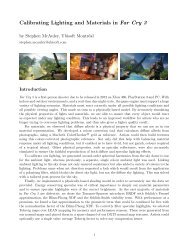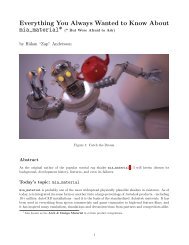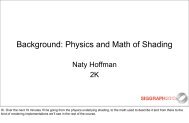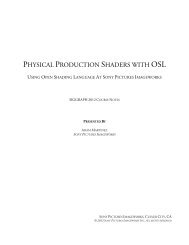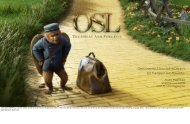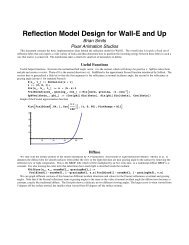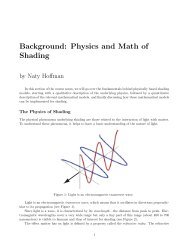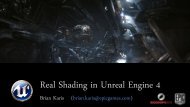Physically-Based Shading at Disney
Physically-Based Shading at Disney
Physically-Based Shading at Disney
You also want an ePaper? Increase the reach of your titles
YUMPU automatically turns print PDFs into web optimized ePapers that Google loves.
© Walt <strong>Disney</strong> PicturesTangled (2010)©<strong>Disney</strong> Enterprises, Inc.We adopted a physically-based shading model for hair on Tangled with gre<strong>at</strong> success, but our ad-hoc m<strong>at</strong>erials were difficult tointegr<strong>at</strong>e with the hair shading.
Wreck-It Ralph (2012)©<strong>Disney</strong> Enterprises, Inc.For Wreck-It Ralph, we wanted to investig<strong>at</strong>e physically-based shading for more general m<strong>at</strong>erials. We were able to develop anew BRDF model used on virtually every surface in the film (except for hair).
Outline• Motiv<strong>at</strong>ion• Measured d<strong>at</strong>a observ<strong>at</strong>ions• <strong>Disney</strong> “principled” BRDF• Production experience on Wreck-It Ralph• Future Work©<strong>Disney</strong> Enterprises, Inc.
Motiv<strong>at</strong>ion©<strong>Disney</strong> Enterprises, Inc.
Which shading model should we use?©<strong>Disney</strong> Enterprises, Inc.
Neumann-NeumannCook-TorranceAshikhmin-ShirleySchlickWolffmodified-PhongPhongalbedo pump-upKurtBlinn-PhongGGXKelemenWardDistribution-BRDFHalfway Vector DiskOren-NayarLafortune©<strong>Disney</strong> Enterprises, Inc.There are a lot of shading models, only a fraction of which are shown here. The best choice for our needs is not obvious, andproviding artists with the choice of model would lead to the parameter explosion we were trying to get away from.
Wh<strong>at</strong> makes a model physically-based?©<strong>Disney</strong> Enterprises, Inc.
Mitsubishi Electric Research Labor<strong>at</strong>ories, 2005©<strong>Disney</strong> Enterprises, Inc.This famous study compared 100 m<strong>at</strong>erials to 5 popular models. The m<strong>at</strong>erials are sorted left to right by rel<strong>at</strong>ive error. He andCook-Torrance performed generally better than the others, but one can observe th<strong>at</strong> there’s more difference between them<strong>at</strong>erials than the models themselves. In particular, the m<strong>at</strong>erials on the right are poorly represented by all the models. Thisbegs the question as to wh<strong>at</strong> is not represented in the models.
A D<strong>at</strong>a-Driven Reflectance ModelM<strong>at</strong>usik et al.ACM Transactions on Graphics, 2003http://merl.com/brdfThe MERL 100©<strong>Disney</strong> Enterprises, Inc.Fortun<strong>at</strong>ely, the d<strong>at</strong>a set is available for free download for academic use.
github.com/wdas/brdfTo explore the d<strong>at</strong>a and compare with analytic models we developed a BRDF viewer and released it as open source. Thisscreenshot shows an approxim<strong>at</strong>e fit between an analytic model and a measured m<strong>at</strong>erial.©<strong>Disney</strong> Enterprises, Inc.
github.com/wdas/brdfThe Theta D curve shows the Fresnel response.©<strong>Disney</strong> Enterprises, Inc.
github.com/wdas/brdfViewing ThetaH vs ThetaD as an image slice provides a powerful and intuitive view of the BRDF space showing all of theimportant characteristics of the m<strong>at</strong>erial.©<strong>Disney</strong> Enterprises, Inc.
A schem<strong>at</strong>ic view of “Image Slice” space comparing two m<strong>at</strong>erials. Note the difference in grazing retro-reflection.©<strong>Disney</strong> Enterprises, Inc.
Viewing all 100 slices <strong>at</strong> once can give an impression of the vari<strong>at</strong>ion seen in measured d<strong>at</strong>a.©<strong>Disney</strong> Enterprises, Inc.
Measured d<strong>at</strong>a observ<strong>at</strong>ions©<strong>Disney</strong> Enterprises, Inc.
Diffuse is not Lambertianred-plasticspecular-red-plasticLambert©<strong>Disney</strong> Enterprises, Inc.Note th<strong>at</strong> the Lambert self-shadow termin<strong>at</strong>or is too dark. Also, the grazing response is fl<strong>at</strong> whereas measured m<strong>at</strong>erials oftenhave a highlight or a shadow. The shadow is predicted by the Fresnel response as more light becomes specular <strong>at</strong> grazingangles and thus less is available for diffuse reflectance.
Diffuse retro-reflection is rel<strong>at</strong>ed to roughness0.50.40.30.20.10.00 30 60 90✓ h0.50.40.30.20.10.00 30 60 90✓ h50 smooth m<strong>at</strong>erials 50 rough m<strong>at</strong>erialsSmooth m<strong>at</strong>erials tend to show a grazing retro-reflective shadow, whereas rough m<strong>at</strong>erials show a retro-reflective peak.©<strong>Disney</strong> Enterprises, Inc.
Diffuse color vari<strong>at</strong>ion examples Top row - spheres lit from point light. Bottom row - BRDF image slices.©<strong>Disney</strong> Enterprises, Inc.
Diffuse models©<strong>Disney</strong> Enterprises, Inc.Oren-Nayar is derived from a rough diffuse surface model and ignores Fresnel and subsurface effects. It exhibits very strongshadowing <strong>at</strong> grazing angles. Hanrahan-Krueger is derived from a subsurface sc<strong>at</strong>tering model and assumes a perfectly smoothsurface. Both models predict a grazing retro-reflection and a fl<strong>at</strong>tening of the diffuse shape, though they have oppositebehaviors <strong>at</strong> grazing angles. Real m<strong>at</strong>erials seem to be somewhere in between.
Unified diffuse/specular roughness Our new model has a single roughness parameter to control both diffuse and specular response.©<strong>Disney</strong> Enterprises, Inc.
Specular models don’t have long enough tails1001.00.010 5 10chrome GGX Beckmann©<strong>Disney</strong> Enterprises, Inc.Black line = measured chrome; red = GGX (from Walter 2007); blue/green line = Beckmann / Blinn-Phong. GGX is a much betterfit but still cannot capture the tail of the measured d<strong>at</strong>a.
Ground Glass D<strong>at</strong>aTrowbridge-ReitzTrowbridge, T. S. and Reitz, K. P.,Average irregularity represent<strong>at</strong>ion of aroughened surface for ray reflection,J. Opt. Soc. Am., 1975We developed a specular model based on Trowbridge-Reitz, the model favored by Blinn in the famous Blinn-Phong paper.©<strong>Disney</strong> Enterprises, Inc.
Ground Glass D<strong>at</strong>aTrowbridge-ReitzBerryTrowbridge, T. S. and Reitz, K. P.,Average irregularity represent<strong>at</strong>ion of aroughened surface for ray reflection,J. Opt. Soc. Am., 1975Berry, E. M., Diffuse Reflection of Lightfrom a M<strong>at</strong>te Surface,J. Opt. Soc. Am., 1923The Berry model was considered by Trowbridge and Reitz and has a much longer tail.©<strong>Disney</strong> Enterprises, Inc.
Ground Glass D<strong>at</strong>aTrowbridge-ReitzBerryTrowbridge, T. S. and Reitz, K. P.,Average irregularity represent<strong>at</strong>ion of aroughened surface for ray reflection,J. Opt. Soc. Am., 1975Berry, E. M., Diffuse Reflection of Lightfrom a M<strong>at</strong>te Surface,J. Opt. Soc. Am., 1923The similar forms between Berry and TR suggest a generaliz<strong>at</strong>ion using an arbitrary power.©<strong>Disney</strong> Enterprises, Inc.
Generalized-Trowbridge-ReitzGTR =1GTR = 2 (TR/GGX)GTR =10Beckmann0 5 10 15 20 25 30©<strong>Disney</strong> Enterprises, Inc.The generalized form can produce a wide range of tail shapes. See course notes for details.
Albedo is mostly fl<strong>at</strong>, and well below 1.01.00.80.60.40.20.00 30 60 90✓ l1.00.80.60.40.20.00 30 60 90✓ l50 smooth m<strong>at</strong>erials 50 rough m<strong>at</strong>erials©<strong>Disney</strong> Enterprises, Inc.Albedo is rel<strong>at</strong>ively fl<strong>at</strong> for all the m<strong>at</strong>erials except for a slight peak near grazing angles. Rough m<strong>at</strong>erials tend to show a largerpeak, presumably due to the grazing retro-reflection.
Albedo of various models smoothroughAnalytic models tend to have significant vari<strong>at</strong>ion in albedo.©<strong>Disney</strong> Enterprises, Inc.
<strong>Disney</strong> “principled” BRDF©<strong>Disney</strong> Enterprises, Inc.
Principles1. Intuitive r<strong>at</strong>her than physical parameters should be used.2. There should be as few parameters as possible.3. Parameters should be zero to one over their plausible range.4. Parameters should be allowed to push beyond where it makessense.5. All combin<strong>at</strong>ions of parameters should be plausible.©<strong>Disney</strong> Enterprises, Inc.
Parameters See course notes for parameter descriptions and details.©<strong>Disney</strong> Enterprises, Inc.
Parameters ©<strong>Disney</strong> Enterprises, Inc.
Parameter blendingParameters are designed to allow robust interpol<strong>at</strong>ion. Here, all 10 parameters are interpol<strong>at</strong>ed linearly.©<strong>Disney</strong> Enterprises, Inc.
Parameter layers©<strong>Disney</strong> Enterprises, Inc.Robust interpol<strong>at</strong>ion enables a simplified layering model where parameters are blended using a Photoshop-like layer stack. Eachlayer can be selected as a preset from the m<strong>at</strong>erial library. The masks are generally texture maps or expressions based ontexture maps.
Production experience onWreck-it Ralph©<strong>Disney</strong> Enterprises, Inc.
Look development• Simplified m<strong>at</strong>erial library• M<strong>at</strong>erial Designer - real-time BRDF editing w/ image-based lighting• More consistent, high-quality results• Almost no lighting re-do’s©<strong>Disney</strong> Enterprises, Inc.
Lighting• IBLs and area lights = big change• Start physical, add art-directed controls• Tone-mapping©<strong>Disney</strong> Enterprises, Inc.
Future Work©<strong>Disney</strong> Enterprises, Inc.
Future Work• Better BRDF / subsurface integr<strong>at</strong>ion• Complex cloth• Iridescence©<strong>Disney</strong> Enterprises, Inc.
In the course notes• Additional observ<strong>at</strong>ions and details about our BRDF• Full deriv<strong>at</strong>ion of GTR distribution• Selected history of 30+ BRDF models used in graphics©<strong>Disney</strong> Enterprises, Inc.
Acknowledgements• Chuck Tappan co-developed our “principled” BRDF.• Christian Eisenacher, Greg Nichols, and Jared Johnson developedour BRDF tools.• Stephen Hill, N<strong>at</strong>y Hoffman, and Pete Shirley provided valuableinput.©<strong>Disney</strong> Enterprises, Inc.



